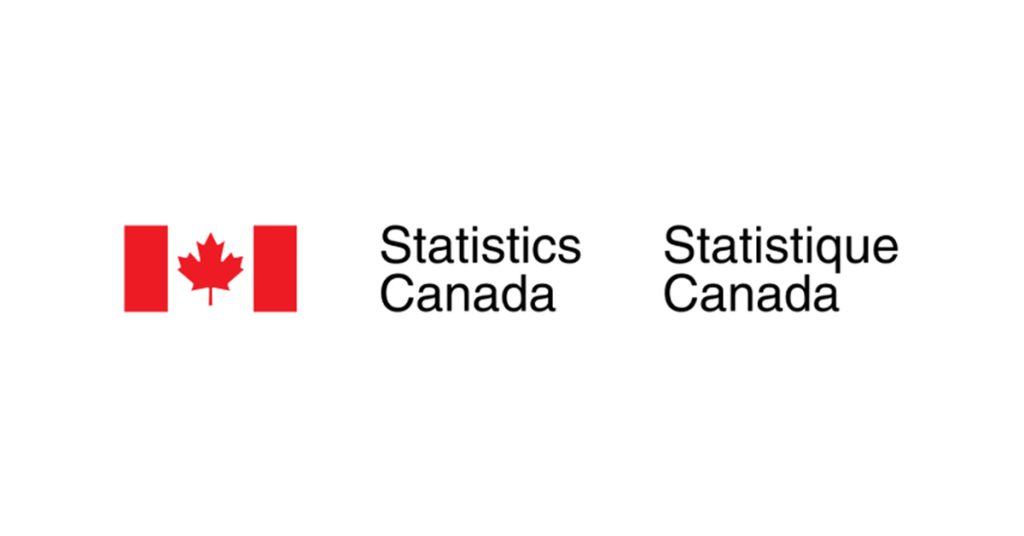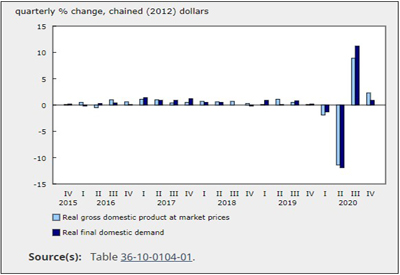Labour Force Survey, December 2024

January 14, 2025
Labour employment rose by 91,000 (+0.4%) in December and the employment rate increased 0.2 percentage points to 60.8%. The unemployment rate declined 0.1 percentage points to 6.7%.
In December, employment rose for core-aged men (25 to 54 years old) (+30,000; +0.4%) and men aged 55 and older (+41,000; +1.7%) as well as for women aged 55 and older (+21,000; +1.1%).
Employment gains in December were led by educational services (+17,000; +1.1%), transportation and warehousing (+17,000; +1.6%), finance, insurance, real estate, rental and leasing (+16,000; +1.1%), and health care and social assistance (+16,000; +0.5%).
In December, employment increased in Alberta (+35,000; +1.4%), Ontario (+23,000; +0.3%), British Columbia (+14,000; +0.5%), Nova Scotia (+7,400; +1.4%), and Saskatchewan (+4,000; +0.7%), while there was a decline in Manitoba (-7,200; -1.0%). Employment was little changed in the other provinces.
Total hours worked rose 0.5% in December and were up 2.1% compared with 12 months earlier.
Average hourly wages among employees were up 3.8% (+$1.32 to $35.77) on a year-over-year basis in December, following growth of 4.1% in November (not seasonally adjusted).
Employment rises in December, capping off 2024 with a comparable growth rate to 2023
Employment rose by 91,000 (+0.4%) in December, mostly in full-time work (+56,000; +0.3%). This follows an increase in November (+51,000) and marks the third employment gain in the past four months.
The year 2024 ended with 413,000 (+2.0%) more people working in December compared with 12 months earlier. This year-over-year growth rate was comparable to the one observed in December 2023 (+2.1%) and to the average growth rate for December over the pre-COVID-19 pandemic period of 2017 to 2019 (+1.9%).
Public sector employment rose by 40,000 (+0.9%) in December, the second consecutive monthly increase. In the 12 months to December, public sector employment rose by 156,000 (+3.7%), driven by gains in the public-sector components of educational services as well as health care and social assistance.
Private sector employment was little changed in December (+27,000; +0.2%) and was up 191,000 (+1.4%) on a year-over-year basis. The number of self-employed people rose by 24,000 (+0.9%) in December, the first increase since February. This brought total gains in self-employment for the year to 64,000 (+2.4%).
Employment rate rises for the first time since January 2023
The employment rate—the proportion of the population aged 15 and older who are employed—increased 0.2 percentage points to 60.8% in December, after holding steady in November. The increase in December was the first since January 2023. On a year-over-year basis, the employment rate was down 0.9 percentage points in December.
Chart 1
Employment rate rises in December

Employment growth in recent months has occurred in the context of slowing population growth. According to the most recent official population estimates, the third quarter of 2024 saw the slowest quarterly population growth since the first quarter of 2022.
Employment increases among core-aged men and people aged 55 and older
Employment increased by 30,000 (+0.4%) among core-aged (25 to 54 years old) men in December, building on an increase of 45,000 in November. The increase in December pushed the employment rate of core-aged men up 0.2 percentage points to 86.7%. Employment for core-aged women was virtually unchanged in December and the employment rate for this group held steady at 80.1%.
In the 12 months to December, employment grew faster among core-aged men (+3.3%; +228,000) than among core-aged women (+1.7%; +110,000).
Infographic 1
Employment rate by age group

Among people aged 55 and older, employment increased both for men (+41,000; +1.7%) and women (+21,000; +1.1%) in December. For men in this age group, the increase was the first since January. On a year-over-year basis, employment was little changed in December for both men and women aged 55 and older.
Among youth (aged 15 to 24), employment was little changed for a second consecutive month in December, and the employment rate was little changed at 53.8%. Over the 12 months of 2024, the youth employment rate fell by 2.5 percentage points, continuing a downward trend that began in April 2023. In December 2024, the youth employment rate was 4.4 percentage points lower than its 2017-to-2019 pre-pandemic average (58.2%).
Unemployment rate ticks down to 6.7%
The unemployment rate was 6.7% in December, down 0.1 percentage points from the previous month. The rate in November was the highest since January 2017 (outside of 2020 and 2021, during the pandemic). On a year-over-year basis, the unemployment rate was up 0.9 percentage points in December.
Chart 2
Unemployment rate declines in December

Infographic 2
Unemployment rate by age group

In December, the unemployment rate fell for core-aged men (-0.2 percentage points to 5.5%) and for men aged 55 and older (-0.8 percentage points to 5.2%). The unemployment rate was little changed among core-aged women at 5.7% and women aged 55 and older at 4.6%.
The youth unemployment rate increased by 0.5 percentage points to 14.4% in December, as more youth searched for work. The cumulative increase in the youth unemployment rate in November and December (+1.6 percentage points), largely offset the cumulative decline seen in September and October (-1.7 percentage points).
Pace of year-over-year wage growth slows
Average hourly wages among employees were up 3.8% (+$1.32 to $35.77) on a year-over-year basis in December, following growth of 4.1% in November and of 4.9% in October (not seasonally adjusted).
Year-over-year average hourly wage growth in December was the slowest since May 2022. The pace of growth had accelerated in the second half of 2022, reaching a peak of 5.8% in November 2022. It generally hovered around 5% throughout 2023 and in the first 10 months of 2024. In December, year-over-year wage growth was faster among women (+4.2%) than among men (+3.4%).
Employment gains spread across several industries for the second consecutive month
Employment rose by 17,000 (+1.1%) in educational services—the second consecutive monthly increase—and in health care and social assistance (+16,000; +0.5%) in December. Over the 12 months of 2024, growth in health care and social assistance (+130,000; +4.8%) and educational services (+71,000; +4.7%) have together accounted for nearly half of employment growth across all industries.
Chart 3
Employment gains spread across several industries in December

Employment in transportation and warehousing increased by 17,000 (+1.6%) in December, rebounding from a similar-sized decline in November. There was little employment change in the industry on a year-over-year basis.
In December, employment rose in finance, insurance, real estate rental and leasing (+16,000; +1.1%), the first significant increase since August 2024. On a year-over-year basis, employment in the industry was up 85,000 (+6.2%).
More people working in Alberta, Ontario, British Columbia, Nova Scotia and Saskatchewan
In Alberta, employment increased by 35,000 (+1.4%) in December, building on gains observed in three of the previous four months. The employment rate rose 0.7 percentage points to 64.8%, and the unemployment rate fell 0.8 percentage points to 6.7%. In the 12 months to December 2024, employment grew by 4.0% (+100,000) in Alberta, twice the pace for Canada as a whole (+2.0%; +413,000).
In Ontario, employment increased by 23,000 (+0.3%) in December, following two months of little change. In the 12 months to December, employment in the province grew 2.6% (+205,000). The unemployment rate in the province held steady at 7.5% in December and was up 1.2 percentage points on a year-over-year basis.
Employment in British Columbia rose by 14,000 (+0.5%) in December. Despite the employment gain, the unemployment rate rose 0.3 percentage points to 6.0% in the month, as more people participated in the labour force. On a year-over-year basis, employment in the province was essentially unchanged.
Employment also increased in December in Nova Scotia (+7,400; +1.4%) and Saskatchewan (+4,000; +0.7%), and the unemployment rates in both provinces were little changed at 6.3% in Nova Scotia and 5.9% in Saskatchewan.
Map 1
Unemployment rate by province and territory, December 2024

Manitoba (-7,200; -1.0%) was the lone province with an employment decline in December, and the unemployment rate in the province increased 0.4 percentage points to 6.2%.
Employment was little changed in Quebec, following an increase in November. With fewer people searching for work, the unemployment rate fell 0.3 percentage points to 5.6%. Compared with December 2023, the unemployment rate in Quebec was up 0.9 percentage points and the employment rate was down 0.9 percentage points to 61.0%.
In the spotlight: In 2024, 8.8% of workers were in industries that were dependent on US demand for Canadian exports
Canada and the United States share a close trading relationship, which supports millions of jobs in each country. Based on Labour Force Survey (LFS) annual employment estimates, in 2024, around 1.8 million people, representing 8.8% of total employment, worked in industries where 35% or more of jobs depended on US demand for Canadian exports.
These industries are identified using the latest available estimates on value-added in exports from the System of Macroeconomic Accounts (see Note to readers for more information).
Industries with the highest proportion of employment dependent on US demand included oil and gas extraction (74.3%), pipeline transportation (71.7%), primary metal manufacturing (60.8%) and transportation equipment manufacturing (56.0%).
Among economic regions in 2024, Wood Buffalo-Cold Lake, Alberta had the highest share of employment in industries dependent on American demand for Canadian exports (22.8%). Other economic regions with above-average proportions of employment in these industries in 2024 included Centre-du-Québec (17.8%), Edmundston-Woodstock, New Brunswick (17.3%), Southern Nova Scotia (17.3%), Banff-Jasper-Rocky Mountain House and Athabasca-Grande Prairie-Peace River, Alberta (16.7%) and Windsor-Sarnia, Ontario (15.4%).
Chart 4
Top 10 economic regions with a high proportion of employment in industries dependent on American demand in 2024

In 2024, workers with a high school diploma or a lower level of education (11.0%) and those with post-secondary education below a bachelor’s degree (9.4%) were more likely to work in industries dependent on American demand for Canadian exports compared with those with a bachelor’s degree or a higher level of education (6.7%). Men (12.5%; 1.3 million workers) were also more likely to work in these industries than women (4.7%; 455,000).
Employment in industries dependent on US demand for Canadian exports tend to pay above-average wages. In 2024, the average hourly wage of employees working in these industries was $37.24, 6.5% higher than for employees in other industries ($34.97).
In the spotlight: Close to 700,000 Canadians did paid work through a digital platform in 2024
Digital platform employment refers to paid work carried out through websites or apps that connect workers with clients and add value by organizing or monitoring work activities. It represents one component of the gig economy, which also includes short paid jobs or tasks performed without the support of online platforms. Since 2022, the LFS has collected information on digital platform employment every December. To learn more about the core concepts of the gig economy, see: Defining and measuring the gig economy using survey data.
In total, 675,000 Canadians, or 2.3% of the population aged 15 to 69, did paid work through a digital platform in the 12 months ending in December 2024 by providing services, renting out accommodation, goods or equipment, or selling goods through websites or apps that coordinated their work activities or managed payments.
This included 498,000 Canadians who provided services through digital platforms. The most common services included the delivery of food or other goods (266,000 people, compared with 278,000 in 2023), personal transport (154,000 people, compared with 135,000 in 2023), and the creation of content, such as videos or podcasts (39,000 people).
Chart 5
Number of persons who did paid work through digital platforms by type of activity, 12 months ending in December 2024

In addition, 54,000 Canadians rented out accommodation through a digital platform and performed work as part of their rental activity in 2024, while 141,000 sold goods to earn income using platforms that coordinated their work activities or managed payments.
Larger proportions of South Asian (5.2%), Black (4.3%), and Chinese Canadians (3.1%) did paid work through a digital platform, compared with Canadians who were not racialized or Indigenous (1.6%). In addition, immigrants who were admitted to Canada in the previous five years were more than three times more likely (5.8%) to have done paid work through a digital platform compared with persons born in Canada (1.6%). Men (2.9%) were also more likely than women (1.7%) to have done paid work through a digital platform in 2024.











